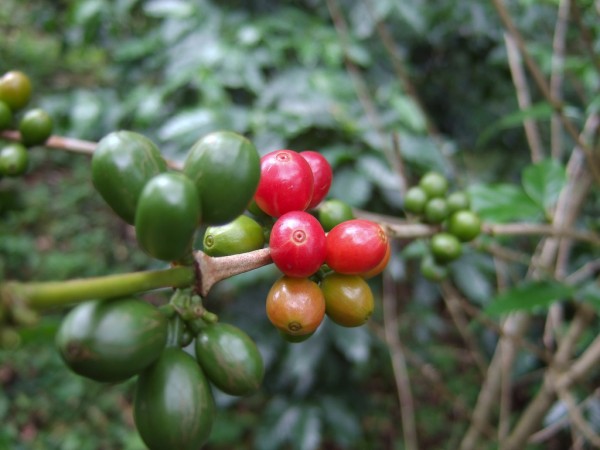(editor’s note: Roast Magazine is in no way affiliated with the Colombia Sensory Trial outside of editorial curiosity. We do agree with the assertion below by Michael Sheridan, this post’s author, that the small sample size of the trial is inherently limiting, but that it nonetheless provides potentially valuable insight into answering the question posed in this headline.)
by Michael Sheridan of CRS Coffeelands blog
The first part of the Colombia Sensory Trial featured coffee buyers and quality control experts from some of the most important coffee organizations in the Americas. During two cupping panels at Intelligentsia Roasting Works in Chicago, they scored pairs of Castillo and Caturra samples collected from 22 farms in Nariño, Colombia.
The second part enlisted highly trained assessors at the Kansas State University Sensory Analysis Center to apply the new World Coffee Research sensory lexicon to those same samples. (More on the WCR sensory lexicon here.)
By the time I presented the preliminary results of the Trial to the SCAA Symposium in April, I had been poring over the cupping scores for months, but had only received the initial results of the lexicon analysis the night before my talk. Since then, I have received final data from the sensory team at KSU and had the chance to carefully review the results with them.
The two approaches were very different, but both led to the same conclusion: G < (E + M).
GxExM is a framework that helps us understand the complex interactions between three related variables. It also helps us explain a broad range of farm-level outcomes including yields, efficiencies, product quality and profitability.
- G: Genotype or Genetics (What you plant. In this case, a coffee variety.)
- E: Environment (Where you plant your chosen coffee variety and the conditions that prevail there–elevation, soils, weather, etc.)
- M: Management (How you manage that coffee variety, including husbandry, harvesting and post-harvest processin.)
We designed the Colombia Sensory Trial to isolate the impact of G, or coffee variety, on cup quality. By selecting samples of Castillo and Caturra grown under identical conditions (environment) by farmers applying the same agronomic, harvest and post-harvest practices to each (management), we felt the design controlled for a lot of variability in E and M.
The results — both the quantitative scores assigned to each variety by expert cuppers and the qualitative attributes assigned by highly trained sensory analysts — showed that E and M were more correlated with cup quality than G.
I have been very intentional about communicating the limitations of the Colombia Sensory Trial methodology: The small sample size did not permit us to generate the kind of statistically robust results we had hoped to. We cannot generalize broadly on the basis of the results of this narrow exercise. With that caveat firmly established…
If we were to see similar results across multiple locations and over multiple years, it would have important implications for growers, buyers and policymakers:
ON THE FARM: What it would mean for growers
For growers choosing between Castillo and Caturra, what they choose to plant may be less important for cup quality then where they plant it and how they manage it. These growers may achieve bigger gains in cup quality through improvements in soil fertility, shade management, harvesting and post-harvest practices than by opting for one variety over another.
IN THE MARKETPLACE: What it would mean for buyers
It becomes increasingly difficult to make a compelling case for Caturra over Castillo to smallholder growers who can ill-afford to assume the additional risk of a rust-susceptible variety (Caturra) if it does not increase in any statistically significant way the probability of higher cup scores (or price premiums). Market incentives for quality improvement might generate more reliable returns if directed toward improvements in management practices or other varieties more likely to achieve separation from Castillo on the cupping table.
IN THE POLICY PROCESS: What it would mean for decision-makers
If E and M are more important than G where Castillo and Caturra are concerned, the people who make policy regarding public support to the coffee sector would be well-advised to increase the “IQ” of extension services. Coffee-growing countries that devote “parafiscal” resources — funds raised through taxes on agricultural production or trade to finance reinvestment in agriculture — to extension services for growers tend overwhelmingly to focus on the M in GxExM: training to improve agronomic practices and farm management. They don’t often incorporate insight on E in extension services, even when that information is readily available.
Coffee institutes that know which environments are suitable for the production of high-quality and which ones aren’t should deliver that information to growers so they can make the best-informed decisions possible about their market strategy. Growers in areas with low probability of producing high cupping scores may make investments oriented toward maximizing yields with relatively less concern for cup quality; their counterparts in environments highly conducive to cup quality may make different decisions about what varieties to plant and how to manage them.
Michael Sheridan
Michael Sheridan is the Chief Executive Officer of the Coffee Quality Institute, a nonprofit organization with a mission to improve coffee quality and the lives of those who produce it. Sheridan has been leveraging market forces to make coffee work for smallholder farmers and farm workers since 2004. Most recently he directed progressive green coffee sourcing activities and direct-trade partnerships at Intelligentsia Coffee. Prior to that he worked to deliver initiatives in the coffee sector in Central and South America on behalf of Catholic Relief Services.
Comment
1 Comment
Comments are closed.







You seem to be implying albeit somewhat indirectly that soil fertility is good for cup quality. I’m curious if there are studies that show that. We have found that most fertilizers are focused on macro nutrients and not micro nutrients and only increase yield not cup quality and that can sometimes actually decrease cup quality.